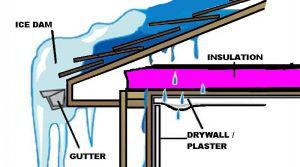While my company was working on a recent  renovation of a client’s mud room in their Great Falls home, the client approached me and asked me to look at a damaged ceiling in their living room and offer a pricing quote to fix it.
renovation of a client’s mud room in their Great Falls home, the client approached me and asked me to look at a damaged ceiling in their living room and offer a pricing quote to fix it.
The damage happened during the winter when water began dripping through the ceiling while they were at home relaxing in front of the fireplace. It seems the heat output from the fireplace exacerbated an ever-worsening leak behind the walls caused by an ice dam.
I told them that first, the leak had to be repaired, and then the drywall. I also advised them that they needed to prevent future ice damming with additional insulation and better roof venting.
What is an Ice Dam?
An ice dam is a ridge of ice that forms at the edge of a roofline and prevents melting snow from draining off the roof. You can often see giant icicles along the roofline. Water backs up behind the dam and can leak into a home by seeping underneath the shingles, causing damage and possible mold formation on ceilings, walls, attics, insulation, and other areas. They are generally caused by non-uniform roof temperatures.
In addition, if the dam breaks fee, it can tear off shingles and gutters and damage what it falls on. If the roof sheathing stays wet it can form mildew and mold and begin to rot.
Air leaks are the leading cause of energy loss in a home, and many of them are found in the attic. In addition, exhaust systems like those in the kitchen or bathroom, and frequent use of a fireplace or woodstove can cause heat and moisture to build up in the attic. Problems arise when warm, moist air from the house travels up through these air gaps, warming the roof enough to melt the ice from underneath and cause condensation inside.
Why Talk About Ice Dams Now? It’s Summer!
I know it’s odd to talk about ice dams now that we’re entering summer; however, this is the perfect time to repair any damage and put into place protection from future problems.
In this particular situation Först Consulting Group recommended a closed-cell spray foam insulation, which although it cannot be used in every application to insulate, made sense. Here, as in most cases, better sealing, insulation and venting in the attic and eaves will solve the problem—and save you money on your fuel bills.
Call Först Consulting Group
If you have indications of, or suspect you have had an ice dam problem, Först Consulting Group can answer your questions or provide an inspection. We can also perform an energy-efficiency survey to detect leaks throughout your home, and offer recommendations for preventing problems next winter in Northern Virginia. Please contact Först to schedule your appointment.




